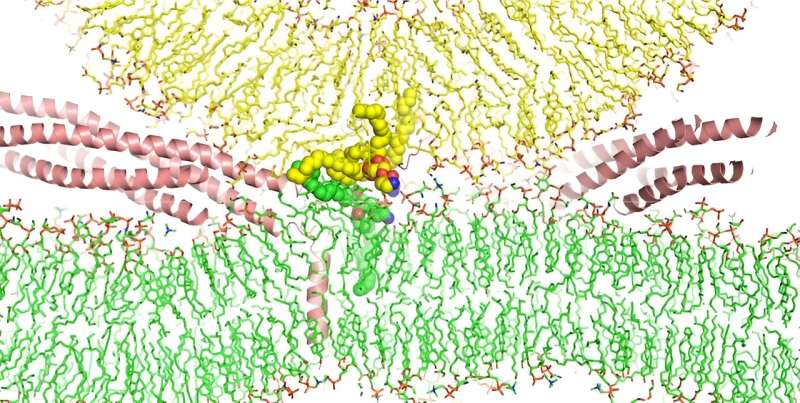This article has been reviewed according to Science X's editorial process and policies. Editors have highlighted the following attributes while ensuring the content's credibility:
fact-checked
peer-reviewed publication
trusted source
proofread
Supercomputer simulation reveals new mechanism for membrane fusion

An intricate simulation performed by UT Southwestern Medical Center researchers using one of the world's most powerful supercomputers sheds new light on how proteins called SNAREs cause biological membranes to fuse.
Their findings, reported in the Proceedings of the National Academy of Sciences, suggest a new mechanism for this ubiquitous process and could eventually lead to new treatments for conditions in which membrane fusion is thought to go awry.
"Biology textbooks say that SNAREs bring membranes together to cause fusion, and many people were happy with that explanation. But not me, because membranes brought into contact normally do not fuse. Our simulation goes deeper to show how this important process takes place," said study leader Jose Rizo-Rey ("Josep Rizo"), Ph.D., Professor of Biophysics, Biochemistry, and Pharmacology at UT Southwestern.
Membrane fusion is essential for life. One quintessential example happens in neurons, cells that form the basis of the nervous system and make up most of the brain, spinal cord, and peripheral nerves. These cells communicate with one another by releasing chemicals called neurotransmitters from vesicles that must fuse with the originating neuron's cell membrane from the inside for neurotransmitters to be released and recognized by other neurons.
All cellular membranes in eukaryotes—organisms whose cells have a membrane-bound nucleus—are made of a double layer of phospholipids, molecules that have a head that interacts with water and a tail that repels it. The heads of these molecules form the inner and outer linings of the membranes, and the tails are sandwiched in between. Phospholipid bilayer membranes surround eukaryotic cells, their nuclei, many of their organelles, and some other features, such as fluid-filled sacs called vesicles that carry cargo within and between cells.
Around 1990, researchers discovered that SNAREs—short for soluble N-ethylmaleimide-sensitive factor attachment protein receptors—play a key role in membrane fusion. The prevailing understanding has been that these proteins form a complex that works like a zipper, bringing membranes into close contact and leading them to fuse. However, explained Dr. Rizo-Rey, studies over the years suggested this theory had significant holes. For example, mutated SNAREs that still brought membranes into contact did not cause them to fuse.
To better understand the role of SNAREs in membrane fusion, Dr. Rizo-Rey and his colleagues tried a different approach. Relying on Frontera—one of the world's fastest supercomputers, housed at the Texas Advanced Computing Center at The University of Texas at Austin—the team ran an all-atom molecular dynamics simulation of a vesicle fusing with a lipid bilayer that mimics neuronal cell membranes.
This type of simulation uses algorithms to predict how all the molecules of a specific system interact based on the properties of the involved atoms—about 5.3 million atoms in this case, which requires enormous computing power to track.
This simulation showed that, rather than just bringing biological membranes together, the SNARE complex induces phospholipids in the cell membrane and vesicles to flip, intermingling their water-repelling tails. This action leads the membranes to fuse and subsequently form a pore that expels the vesicle's contents outside the cell.
Dr. Rizo-Rey cautioned that further research is necessary to confirm this mechanism occurs in cells. However, he said, the simulation's findings make a lot of sense from a physicochemical point of view and fit well with those from several other cell fusion studies over the years.
Although there are no immediate health-related implications for this discovery, he added, researchers may eventually be able to use these findings to craft new therapies for a variety of neurological diseases such as Alzheimer's disease, Parkinson's disease, schizophrenia, and epilepsy, conditions in which some existing treatments already focus on promoting or inhibiting neurotransmitter release.
Diabetes, heart disease, high blood pressure, cancer, and viral infections also depend highly on membrane fusion and could eventually be treated by intervening in this process, Dr. Rizo-Rey said.
More information: Josep Rizo et al, Molecular mechanism underlying SNARE-mediated membrane fusion enlightened by all-atom molecular dynamics simulations, Proceedings of the National Academy of Sciences (2024). DOI: 10.1073/pnas.2321447121
Journal information: Proceedings of the National Academy of Sciences
Provided by UT Southwestern Medical Center



















